• Puffy, round, moon-shaped face, often called “chipmunk cheeks”. • Water retention (edema). To reduce water retention, avoid salty foods. • Acne. • Hair growth on face and body. • Mood swings including irritability, agitation, euphoria or depression. • Insomnia. • Easy bruising due to fragile, thinning skin. • High blood pressure (hypertension). • High blood sugar (hyperglycemia); symptoms include blurred vision, thirst and more frequent urination. • Increased risk of infection. • Stomach ulcers and upset stomach; to protect the stomach, take steroids with food. • Hyperactivity. Long-term side effects • Osteoporosis (thinning of the bones); Calcium and Vitamin D supplements and other medications can help prevent osteoporosis. • Glaucoma and cataracts. • Muscle weakness. • Adrenal insufficiency. • Osteonecrosis (or avascular necrosis); damage to the bones caused by impaired blood flow. It most often occurs in the hips, but can also affect the shoulders, knees and other joints, sometimes requiring joint replacement. • Premature arteriosclerosis; in combination with other risk factors including lupus itself, long-term use of corticosteroids can lead to a narrowing of the blood vessels by fat (cholesterol) deposits, which can cause heart attacks and strokes. Managing your medication: If you have a question about your steroids, ask your doctor. It is important that you understand what steroids do, how much you should take and when. If you’ve forgotten to take your steroids, take it as soon as you remember. Don’t wait until the next day, and do not double the medication you take to make up for a missed dose. Use a pill organizer to keep track of your pills, to remind you when to take the medications, and to help you recognize when you’ve missed a dose. If you require a blister pack, speak with your pharmacist and lupus team. When tapering your medication, it’s a good idea to ask your doctor to write down your tapering schedule. Use a calendar or tape the directions to your refrigerator or cupboard door. Refer to it when you refill your pill organizer each week. It is also wise to wear a MedicAlert® bracelet or carry a card that provides information about the medica- tions you are taking. Since it is common for your steroid dosages to change, especially if you are tapering your medication, keep the card up-to-date. You will need to know this information for all of your different doctor’s appointments. Adjusting your dosage of corticosteroids without your doctor’s supervision is risky. Abruptly stopping the medication is also very dangerous and could be fatal. Since corti- costeroids used to treat SLE, such as prednisone, are very similar to cortisone pro- duced naturally by the body’s adrenal glands, the body may stop producing the hor- mones that drive the natural production of cortisone while on a synthetic steroid. 53
 Living Well With Lupus Facts Booklet Page 52 Page 54
Living Well With Lupus Facts Booklet Page 52 Page 54